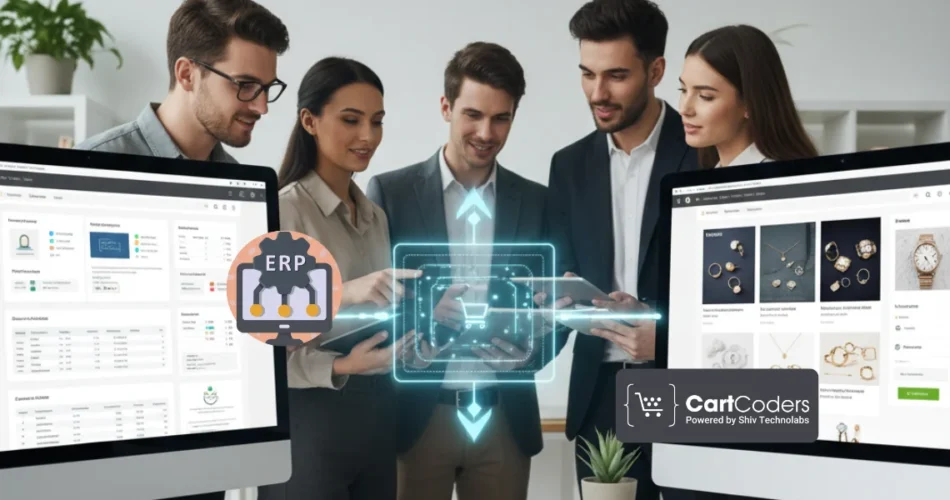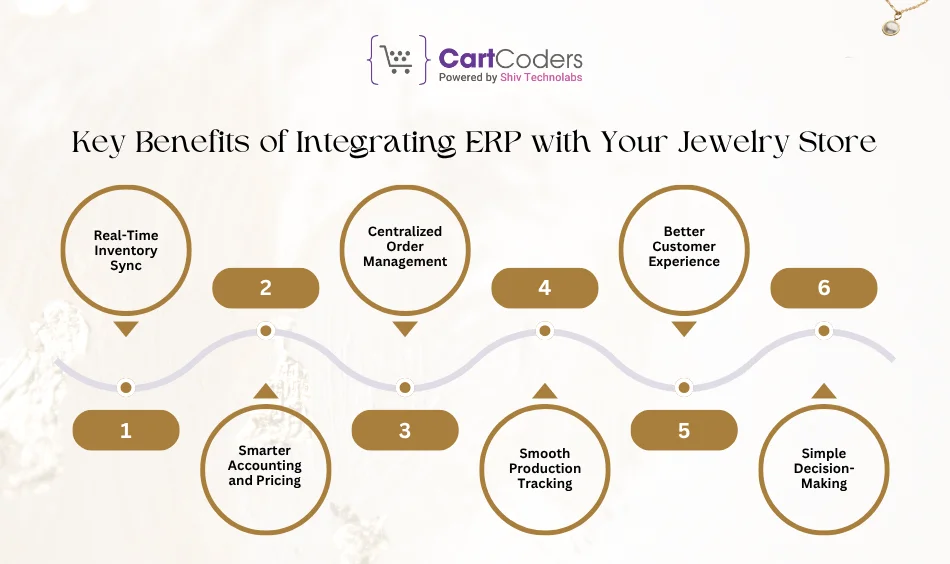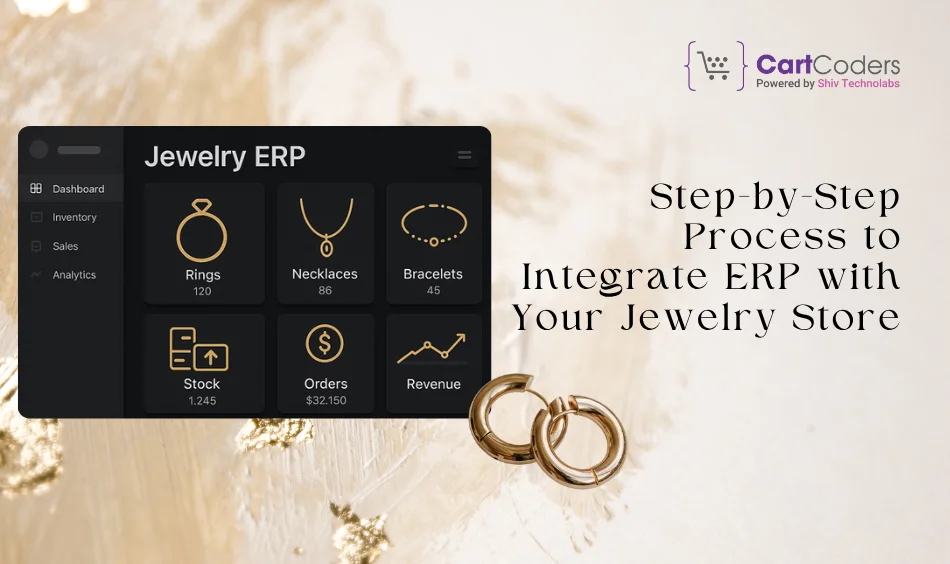Custom Engagement Solutions
Unlock tailored solutions with a free, no-obligation strategy session.
Expert Developers & Engineers on Demand
Scale Your Team with Skilled IT Professionals
Expert Guidance for Digital Transformation

The jewelry business is glittering again — but this time, it’s digital. In 2025, online jewelry sales are expected to touch $60 billion, driven by younger shoppers who buy engagement rings straight from their phones.
AR try-ons, virtual stylists, and AI-powered recommendations are changing how buyers choose sparkle. Yet, behind every shining product photo lies a storm of inventory issues, gold-rate updates, and custom-order chaos that spreadsheets can’t handle.
That’s where ERP integration becomes the hidden gem of the trade. It turns scattered data into a single source of truth — linking your eCommerce store, accounting, production, and CRM together.
Whether you sell handcrafted jewelry or luxury diamonds, an ERP system keeps every carat, order, and invoice in sync — preparing your brand for a faster, smarter digital future.
Running an online jewelry business in 2025 means managing more than just sales. The modern jewelry buyer expects real-time product availability, certified authenticity, and accurate pricing that adjusts with daily gold rates.
Yet, most small to mid-size jewelry brands still juggle between spreadsheets, emails, and manual order entries — a recipe for confusion and lost revenue.
Many jewelry brands report inventory mismatches and order delays when relying on manual workflows. Connecting your store with an ERP reduces double entries and keeps stock, orders, and billing in sync.
These inefficiencies don’t just slow business; they damage trust — a critical factor when you’re selling products worth thousands of dollars.
ERP integration changes this entirely. By connecting your eCommerce store with a robust ERP system, every sale, repair order, and workshop update flows automatically across departments. No double entries. No missing stock. No billing mismatches.
Here’s why it’s becoming essential for every jewelry brand serious about scaling:
As jewelry brands aim to expand globally, ERP isn’t just another tool — it’s the foundation of reliable, automated, and growth-ready operations.

Integrating an ERP system into your jewelry eCommerce store simplifies how your business runs every single day. It replaces scattered spreadsheets and manual updates with one connected process. From gold stock to customer history, everything becomes traceable, accurate, and easy to manage.
Here are the main benefits your jewelry brand can experience:
Your ERP keeps track of every product and material the moment it moves. Whether it’s a sold ring, a repaired necklace, or a restocked bracelet, your store and backend always show the same count.
All transactions automatically reflect in your accounts. You can manage invoices, taxes, and pricing changes for different materials without manual edits.
Every order—online, offline, or from multiple sales channels—flows into one dashboard. You’ll know exactly what’s sold, pending, or shipped.
Custom jewelry involves several steps: design, casting, polishing, and quality check. ERP connects these stages so you can follow each order’s journey easily.
When customers see clear order updates and accurate delivery timelines, they feel confident shopping with you again.
With all reports in one place, you get a clear view of sales, expenses, and product performance—helping you plan what to make or promote next.
An integrated ERP system brings order to creative chaos. It lets you focus on design and growth while the system handles the rest quietly in the background.
Integrating ERP with your jewelry eCommerce store may sound complex, but it’s quite straightforward once the process is set up correctly. The goal is simple — your online store and backend system should talk to each other automatically. Every sale, refund, or stock update moves between the two without manual entry.
Here’s how it typically works in a jewelry business setup:
This integration eliminates duplication, speeds up workflow, and keeps every department — from sales to production — perfectly aligned. Once it’s active, your business operates smoothly with fewer errors and faster turnaround times.
Not every ERP fits the jewelry trade. You need a system that understands both the retail side of eCommerce and the workshop side of production.
Jewelry businesses handle complex variables like purity, stone weights, hallmarking, and repair jobs. That’s why choosing the right ERP matters.
Here are some widely used ERP systems that pair well with jewelry eCommerce platforms such as Shopify, WooCommerce, or Magento:
| ERP System | Best Suited For | Integration Type | Key Features for Jewelers |
| Odoo ERP | Growing jewelry brands that want flexibility | API or custom connector | Real-time stock sync, multi-store handling, production workflow, and POS support |
| Zoho ERP | Small to mid-size stores focusing on automation | Prebuilt integration | Billing, CRM, analytics, and reporting tools |
| TallyPrime | Regional or Indian jewelers needing an accounting focus | Third-party connector | GST-ready accounting, purchase, and sales management |
| SAP Business One | Established jewelry enterprises with multiple branches | Middleware integration | Centralized operations, HR, advanced reporting, and compliance tracking |
| ERPNext | Tech-savvy jewelry startups | API-based open-source system | Job tracking, vendor management, and production cost analysis |
Each of these systems can be customized depending on your workflow. The ideal ERP for your jewelry brand should fit your scale, staff size, and how much of your process you want to automate.
Once connected, your eCommerce store runs like clockwork — every sale, invoice, and gold update stays in sync automatically.

Integrating an ERP system with your jewelry eCommerce store is more than connecting two tools — it’s building a unified digital backbone that keeps your sales, stock, and finance in sync.
Each phase matters, especially when dealing with products that involve purity levels, stone weights, and complex pricing. Let’s break the process down in detail:
Before any technical setup begins, take a deep look at how your jewelry business operates daily. Identify your biggest challenges — maybe stock mismatches, manual billing, delayed updates, or incomplete customer records.
Create a list of what needs automation:
This analysis becomes your blueprint. Without it, integration might connect systems but fail to fix real problems.
The ERP you pick defines how well your business runs after integration. Focus on scalability and jewelry-specific workflows.
When evaluating options like Odoo, Zoho, TallyPrime, or SAP, consider:
A growing brand should choose an ERP that can expand with time instead of replacing it later.
Once you select the ERP, integration begins. The goal is to make your Shopify, WooCommerce, or Magento store exchange data automatically with your ERP.
This step includes:
Developers handle the setup, but your input is key — they’ll need access to your store admin, ERP credentials, and workflow details to build accurate syncs.
Mapping is the heart of a successful integration. It decides how information from your store matches the ERP database.
Here’s what typically needs alignment:
Even a small mismatch — like “18KT” vs “18k” — can cause major sync errors later. Careful mapping ensures both systems speak the same language.
Never skip testing. It’s where hidden issues appear before they affect live customers.
Perform trial runs such as:
Review every test result carefully. Confirm that quantities, prices, and statuses match perfectly across both systems. Testing prevents downtime or customer complaints later.
Integration success depends on how well your team adopts it. Schedule short training sessions for your staff covering:
Once everyone is comfortable, you can go live confidently. After launch, monitor the first few weeks closely — fix any sync delays, verify report accuracy, and take feedback from your operations and sales teams.
Integration doesn’t end once it’s live. Regular maintenance keeps your ERP and store aligned as you add new products, promotions, or updates.
Set monthly or quarterly review cycles to:
With consistent monitoring, your ERP integration remains reliable and scales effortlessly with your jewelry brand’s growth.
Even the best ERP systems can fail to deliver results if the integration process isn’t planned properly. Jewelry businesses, in particular, deal with intricate product details and fast-moving order workflows — so small errors can create major complications.
Here are the most common mistakes to avoid when connecting your ERP with your jewelry eCommerce store:
Avoiding these mistakes keeps your ERP setup efficient and reliable. It also helps your jewelry business enjoy what integration promises — clarity, control, and consistent growth.
The cost and time required to integrate an ERP with your jewelry eCommerce store depend on how large your business is, which ERP you choose, and how complex your operations are.
For example, a small handcrafted jewelry brand might only need order and accounting sync, while a growing D2C jeweler may require a full-scale connection that includes production tracking, CRM, and POS.
Below is a general overview of what you can expect in terms of cost and development time:
| Store Size | ERP Type | Integration Cost (USD) | Approx. Timeline | Best Suited For |
| Small (up to 100 SKUs) | Zoho / Tally | $1,000 – $2,500 | 2–3 weeks | Startups or local jewelers managing simple online sales |
| Medium (100–500 SKUs) | Odoo / Zoho Custom | $3,000 – $6,000 | 4–6 weeks | Expanding brands that handle made-to-order and retail sales |
| Large (500+ SKUs, Multi-Channel) | SAP / Custom ERP | $8,000 – $15,000 | 6–10 weeks | Enterprises with multiple stores, warehouses, or international operations |
Additional Cost Factors:
Typical Process Duration:
While the numbers vary slightly between providers, the result remains the same — smoother management, fewer manual tasks, and faster operations once your ERP is live.
Integrating an ERP with your jewelry eCommerce store may seem achievable internally, but in practice, it’s a highly specialized task. Jewelry businesses have unique workflows that general ERP consultants often overlook — such as karat-based pricing, stone certifications, repair orders, and workshop tracking. That’s where an experienced integration partner can make a big difference.
Working with a Shopify ERP integration partner means you get experts who understand both sides — the logic of ERP systems and the structure of eCommerce platforms. They design custom connectors, handle real-time syncing, and test every workflow before launch. This ensures your data moves flawlessly between your store, ERP, and accounting systems.
At CartCoders, we’ve helped multiple jewelry brands connect their Shopify stores with ERP systems like Odoo, Zoho, and Tally, tailored to how they actually work. Whether you need a direct connector, custom API, or full setup for inventory and production management, our team builds it end-to-end and stays involved post-launch for maintenance and support.
ERP integration isn’t just a one-time project. It’s an evolving setup that grows with your store. Having a skilled Shopify partner by your side keeps everything running reliably while you focus on design, sales, and expansion.
ERP integration has become one of the most valuable upgrades for jewelry businesses moving toward a scalable future. It brings structure to daily chaos — connecting design, sales, accounting, and fulfillment into one organized system. Instead of relying on manual updates, you get real-time visibility across every stage of your business.
For jewelry brands, this isn’t just a tech improvement — it’s a long-term business investment. When your store and ERP work together, errors drop, processing speeds up, and your customers experience smoother service from order to delivery.
Whether you’re a small local jeweler or a growing online brand, setting up ERP integration early saves time, cost, and confusion later. It’s the foundation that allows your creativity and craftsmanship to shine, supported by a system that’s built for precision and growth.
Odoo and Zoho are often preferred by jewelry brands because they’re flexible, support real-time stock management, and can track purity, stones, and custom orders with ease.
On average, it takes 4 to 6 weeks, depending on the ERP type, data size, and custom workflow setup. Small stores can complete the process faster, while larger brands may need additional testing time.
Yes, most modern ERPs allow multi-store integration. It lets you manage stock, sales, and customer data from different Shopify stores under a single dashboard.
Absolutely. Even small jewelers benefit from integration by automating invoicing, maintaining accurate stock, and managing repairs and returns — saving hours of manual effort every week.
Orders, products, stock levels, customer details, invoices, and return records are synced automatically. Some setups also include shipping and payment data for complete order visibility.
No, once your ERP is connected, it runs through user-friendly dashboards. Your integration partner handles the setup and ensures your team understands how to use it effectively.
Yes, most ERPs are modular. You can start with inventory and accounting, then add production, CRM, or HR modules as your jewelry business grows.
Not if handled correctly. A professional setup ensures testing happens on a staging environment first, keeping your live store safe and uninterrupted during integration.
Post-launch support includes monitoring syncs, applying updates, and resolving any data mismatches between ERP and store. Most integration partners offer monthly or quarterly maintenance.
CartCoders specializes in Shopify ERP integrations for jewelry brands. Our team builds customized connectors, sets up data syncs, and provides ongoing support to keep your operations running smoothly and efficiently.
Projects delivered in 15+ industries.
95% retention rate, building lasting partnerships.
Serving clients across 25+ countries.
60+ pros | 10+ years of experience.